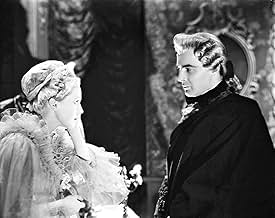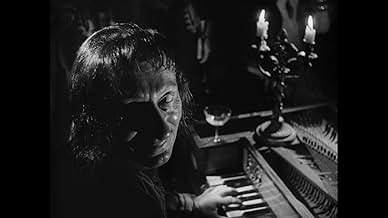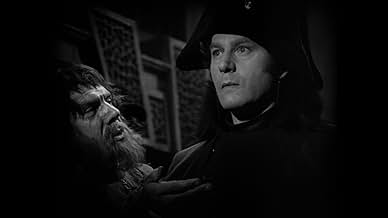The Queen of Spades
- 1949
- 1 घं 35 मि
अपनी भाषा में प्लॉट जोड़ेंAn army officer becomes obsessed with learning the secret to a card game for which an elderly countess sold her soul years earlier.An army officer becomes obsessed with learning the secret to a card game for which an elderly countess sold her soul years earlier.An army officer becomes obsessed with learning the secret to a card game for which an elderly countess sold her soul years earlier.
- निर्देशक
- लेखक
- स्टार
- 1 BAFTA अवार्ड के लिए नामांकित
- 3 कुल नामांकन
- Countess's Lover
- (as Yusef Ramart)
फ़ीचर्ड समीक्षाएं
A Tale of Old St. Petersbvrg.
"In 1806 the craze for gambling had spread throughout Russia. Faro-a simple card game similar to our snap-was all the fashion, and fortunes were won and lost on the turn of a card. As a result there arose many superstitions concerning the cards-one of these was the evil influence of THE QVEEN OF SPADES."
The dead shall give up their secrets.
Haunting, poetic, lyrical, romantic and visually arresting, Thorold Dickinson's take on the Pushkin story is a magnificent picture of many wonders. It's a film that (thankfully) is hard to pigeon hole, it's very unique, a uniqueness that marks it out as an oddity of sorts, ensuring it has stayed as a cult classic rather than a mainstream one. However, now widely available on DVD (the Optimum Region 2 issue is a spankingly fine transfer), and with Martin Scorsese lending his weight to the film's greatness, it's hoped that more people will get to see and embrace this masterpiece.
Dickinson (Gaslight) was only brought in at the last minute, literally days before the picture went into production. Armed with only a tiny budget and confined to the stages of Welwyn Studios, the director gave a lesson in classic film making. The story is a more than solid source to work from, Walbrook's Tsarist Captain Suvorin aspires to gain wealth by learning Countess Ranevskaya's (Evans) secret to wining at the card game Faro. Working from a book he located about people making deals with the Devil, Suvorin worms his way into the affections of the Countess' ward, Lizaveta Ivanova (Mitchell), so as to get close to the aged and fragile Countess and put the squeeze on the old dear. He is obsessed and oblivious to the feelings of others and ignorant to the age old adage about being careful about what you wish for.....
Filmed in subtle black and white by Otto Heller (They Made Me A Fugitive), film is big on shadows, odd camera angles, clinical sound work and haunting imagery. Atmosphere is everything in a film like this, and this has it in abundance, even during the more exuberant passages, such as the gaiety of a dance, there's a disquiet hanging in the air, William Kellner's brilliantly baroque sets observers of impending doom. A number of images burn into the soul, a spider climbing its web, a doused candle and the eerie sight of distorted figurines in glass jars, these are just some of the shots worthy of inspection. Mirrors, too, play a prominent part in proceedings, hauntingly so, while many of the characters have an other worldly sheen to them.
3, 7 & Ace.
Mostly the film is highly thought of by those that have seen it, what negative reviews I have come across appear to be written by horror fans unhappy with not getting the horror film suggested by tag words such as ghost and the Devil. For the first hour it's pretty much about characterisations, psychological make ups and back story, it's not until the hour mark when things start moving towards the spooky. But this film is not horror, as mentioned earlier, it's hard to pigeon hole it for it covers a number of bases. It's more in line with Rebecca and either of the Gaslight movies, an opulent period piece with supernatural overtones, while the visual style of it is very much like The Spiral Staircase. If you like those movies? Then it's pretty nailed on that this is the movie for you. Cast are terrific, Walbrook (Gaslight/The Red Shoes) is intense and maniacal, Evans (The Importance of Being Earnest) is oddly scary but pitiful, Mitchell is beautiful but perfectly staid and Howard (son of Leslie) is straight backed and gentleman like.
From the opening credits that are off kilter written on scratchy looking paper, accompanied by Auric's blunderbuss music score, to the "devilment" of the denouement, this is a classic Ealing film for true classic film fans. 10/10
The story is based on Alexander Puschkin's novella, "The Queen of Spades (1834), about a young captain in the Russian army (Anton Walbrook), an outsider (because he's German) who secretly covets the wealth and position of his fellow officers. When he discovers that an aged countess has sold her soul to the devil in exchange for eternal fortune at the card table, he attempts to gain entry to the household by seducing the countess' naive ward, but his envy envy leads to the dowager's death, a loveless marriage, and Herman's descent into madness.
The production initially ran into some trouble with director Thorold Dickinson entering the project when a great deal of the pre-production was already done. With his limited resources and the inadequate sets and sound stage facilities of the Welwyn Studios, he incorporated as many camera, lighting and special effects as he could devise, and with good effect. The film looks great. Atmosphere in these kind of films is half the work, and they surely did a great job. The acting is somewhat stagy and highly stylized, but this was probably a common characteristic in British acting in those days, and I don't think of Anton Walbrook as a great actor, but the rest of the cast is fine, with Edith Evans in great form as the countess. All in all, not an undiscovered masterpiece, but a fine British chiller with a great period atmosphere.
Camera Obscura --- 8/10
I don't know why this film is so unknown. It reminds me a little of "The Haunting" based on a Shirley Jackson novel, in that one is never really sure if supernatural activity is really going on, or if the main character has finally lost his mind and is imagining everything. I long for the day when this film reappears on video.
I was fortunate enough to see it on cable, where by coincidence it was shown right after 'The Third Man' and just before another Brtish b/w masterpiece, 'The Haunting' -- what a triple bill! In fact there are several connections between QOS and 'The Haunting', including Jack Clayton, who produced the former and directed the latter, and composer Georges Auric, who scored both. There are also close connections with The Archers (Powell & Pressberger) -- Anton Walbrook featured in three P&P films, and co-writer Rodney Ackland also scripted one of those films, P&P's '49th Parallel'.
Watching 'Queen Of Spades' it's obvious that many of the team who made it learned their craft in the silent era -- lighting, costumes, set design and cinematography are all fantastic, and though on a slightly smaller and more restrained scale, QOS is almost on a par with Von Sternberg's baroque masterpiece 'The Scarlett Empress'.
Brilliantly directed by Torold Dickinson (who also did 'Gaslight', in which Walbrook also features), the incredible, wildly expressionistic b/w cinematography is by legendary Czech-born DOP Otto Heller, who began his career in 1922(!) and who also shot Olivier's 'Richard III', 'The Ladykillers', Powell's 'Peeping Tom' and those three classic Michael Caine films of the 60s, The 'Ipcress File', 'Alfie' and 'Funeral In Berlin.'
The casting is perfect, and it's easy to see why Anton Walbrook was one of Michael Powell's favourite actors. His portrayal of the odious Suvorin is a tour de force, and he is matched by the great Edith Evans as the Countess. The crucial scene in which Suvorin tries unsuccessfully to beg, cajole, and finally force the secret of the cards from the Countess is truly electrifying -- Walbrook is absolutely rivetting, and Evans -- who has no lines and plays the scene only with her eyes -- shows why she was considered one the greatest actors of her generation. The climax of that scene, the look of stark horror on Walbrook's face, is one of the most powerful film moments I've ever seen, perhaps only surpassed by incredible card-game scene at the end of the film.
क्या आपको पता है
- ट्रिवियाThe studio was right beside a train line and very badly sound-proofed. They had to post a man on the studio roof to watch out for trains so filming could be suspended while the trains went past.
- भाव
Capt. Herman Suvorin: [he surprises the Old Countess] Don't cry out! Don't be alarmed, please, don't be alarmed. I don't mean you any harm. I've come to ask a favour of you. That's all. A favour. It'll cost you nothing. But to me, it will bring happiness for the rest of my life. I want the secret of the cards. That's all. Come, what is it? The three cards. The names of the three cards. Please! Oh, it's no use pretending you don't know anything about it. I know you were given the secret. And I know who gave it to you. Please! Just think those three words aloud. And I'll trouble you no more. I'll go. What good is the secret to you? For whom are you keeping it? For your grandson? He's rich enough. What would another fortune mean to him, a wastrel and a spendthrift? But I'm not a man of that sort. I know the value of money. I could do great things, I tell you. Great things! If only I had money.
Capt. Herman Suvorin: [sinking to his knees, he continues] For the love of God! If you've any human feeling in your breast, you can't refuse me. I beg. I beseech you. I know why you won't speak. The secret is connected with some terrible sin. That's it, isn't it? I'll make a bargain with you; tell me your secret and I'll take your sin upon my soul. Do you hear me? I mean it. A bargain. I'll take your sin upon my own soul. Oh, speak! Speak to me! You old sphinx.
Capt. Herman Suvorin: [he brandishes a pistol and continues] By God, I'll make you. I ask for the last time, are you going to tell me the secret of the cards? Or are you not?
- क्रेज़ी क्रेडिटThe opening credits, rather than simply reading "Screenplay By", "Music By", "Director of Photography", etc., as in most films, read "The Screenplay By", "The Music By", "The Director of Photography", "The Art Director", etc.
- कनेक्शनReferenced in Lettre de Sibérie (1958)
टॉप पसंद
- How long is The Queen of Spades?Alexa द्वारा संचालित
विवरण
- रिलीज़ की तारीख़
- कंट्री ऑफ़ ओरिजिन
- भाषा
- इस रूप में भी जाना जाता है
- Pikova dama
- फ़िल्माने की जगहें
- उत्पादन कंपनियां
- IMDbPro पर और कंपनी क्रेडिट देखें
- चलने की अवधि1 घंटा 35 मिनट
- रंग
- पक्ष अनुपात
- 1.37 : 1
इस पेज में योगदान दें



































